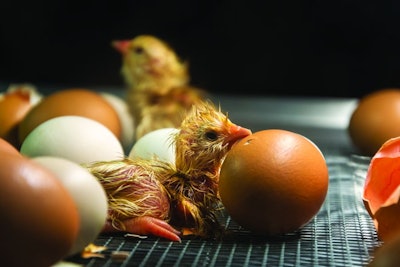
Conditions in the hatchery, including incubation temperature and a post-hatch feeding strategy (early or delayed feeding after hatch), could have positive long-term impacts on broiler health.
“The poultry industry is looking at a lot of methods nowadays to reduce antibiotic usage. Most of these focus on the periods where the broilers are living, for example, by feed manipulations or management of the broilers,” explained Jan Wijnen, researcher, HatchTech, who conducted the study while earning his Ph.D. at Wageningen University.
“What this shows is that it’s also really important to look at incubation.”
How incubation conditions affect broiler health
The first part of the research project evaluated how changes in egg temperature patterns in the incubator influenced chicken quality at hatch, growth performance and immune related responses.
Further research focused on the incubation temperature pattern that showed the most promise in the first experiment.
Wijnen tested whether a combination of specific incubation temperature patterns and post hatch feeding helped improve broiler response to necrotic enteritis or respiratory colibacillosis three weeks post hatch.
“From the beginning, I hypothesized that the feeding treatment would be more important, but the results actually showed that – while feeding was indeed important – the biggest differences were seen in incubation temperature” Wijnen said.
A constant eggshell temperature of 100 °F throughout incubation in combination with early feeding provided the best resilience to intestinal and respiratory diseases during grow out. This was expressed by the lowest losses in growth performance, milder disease morbidity and lower mortality rates, according to Wijnen’s thesis.
“It’s impossible to avoid any differences in incubation temperature, but these results show that it’s really necessary to check whether your actual egg temperatures are optimal and that the variation is as low as possible,” Wijnen added.
“I think we should have the aim to reduce this even further to optimize post-hatch performance and disease resilience. And I think, if managed correctly, early feeding by means of direct access to feed and water after hatch could be considered a strategy to improve broiler resilience.”

















